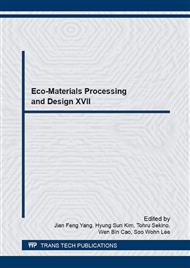[1]
X. Huang, P. Jiang, T. Tanaka, A review of dielectric polymer composites with high thermal conductivity, IEEE Electr. Insul. Mag. 27 (4) (2011) 8-16.
DOI: 10.1109/mei.2011.5954064
Google Scholar
[2]
W. S. Lee, J. Yu, Comparative study of thermally conductive fillers in underfill for the electronic components, Diam. Relat. Mater. 14 (10) (2005) 1647-1653.
DOI: 10.1016/j.diamond.2005.05.008
Google Scholar
[3]
Y. Yao, X. Zeng, K. Guo, R. Sun, J. -B. Xu, The effect of interfacial state on the thermal conductivity of functionalized Al2O3 filled glass fibers reinforced polymer composites, Composite Part A. 69 (2015) 49-55.
DOI: 10.1016/j.compositesa.2014.10.027
Google Scholar
[4]
L.M. McGrath, R.S. Parnas, S.H. King, J.L. Schroeder, D.A. Fischer, J.L. Lenhart, Investigation of the thermal, mechanical, and fracture properties of alumina-epoxy composites, Polymer 49 (4) (2008) 999-1014.
DOI: 10.1016/j.polymer.2007.12.014
Google Scholar
[5]
Y. Hu, G. Du, N. Chen, A novel approach for Al2O3/epoxy composites with high strength and thermal conductivity, Compos. Sci. Tech. 124 (2016) 36-43.
Google Scholar
[6]
C. -Y. Hsieh, S. -L. Chung, High thermal conductivity epoxy molding compound filled with a combustion synthesized AlN powder, J. Appl. Polym. Sci. 102 (5) (2006) 4734-4740.
DOI: 10.1002/app.25000
Google Scholar
[7]
C. Zhi, Y. Bando, T. Terao, C. Tang, H. Kuwahara, D. Golberg, Towards thermoconductive, electrically insulating polymeric composites with boron nitride nanotubes as fillers, Adv. Funct. Mater. 19 (12) (2009) 1857-1862.
DOI: 10.1002/adfm.200801435
Google Scholar
[8]
A.J. Kinloch, A.C. Taylor, The toughening of cyanate-ester polymers Part I Physical modification using particles, fibres and woven-mats, J. Mater. Sci. 37(3) (2002)433-60.
Google Scholar
[9]
E.H. Andrews, Fracture in polymers. 1st ed. Edinburgh: Oliver & Boyd; (1968).
Google Scholar
[10]
B.B. Johnsen, A.J. Kinloch, R.D. Mohammed, A.C. Taylor, S. Sprenger, Toughening mechanisms of nanoparticle-modified epoxy polymers, Polymer 48 (2007) 530-541.
DOI: 10.1016/j.polymer.2006.11.038
Google Scholar
[11]
A. Jabbar, J. Militky, B.M. Kalea, S. Rwawiirea, Y. Nawabb, V. Bahetiaa, Modeling and analysis of the creep behavior of jute/green epoxy composites incorporated with chemically treated pulverized nano/micro jute fibers, Ind. Crop. Prod. 84 (2016).
DOI: 10.1016/j.indcrop.2015.12.052
Google Scholar
[12]
Z. Dai, Y. Gao, L. Liu, P. Potschke, J. Yang, Z. Zhang. Creep-resistant behavior of MWCNT-polycarbonate melt spun nanocomposite fibers at elevated temperature. Polymer 54(14) (2013) 3723-3729.
DOI: 10.1016/j.polymer.2013.05.013
Google Scholar
[13]
Y. Jia, Z. Jiang, J. Peng, X. Gong, Z. Zhang. Resistance to time-dependent deformation of polystyrene/carbon nanotube composites under cyclic tension. Composite Part A. 43(9) (2012)1561-1568.
DOI: 10.1016/j.compositesa.2012.04.011
Google Scholar
[14]
X. Wang, L. -X. Gong, L. -C. Tang, K. Peng, Y. -B. Pei, L. Zhao, L. -B. Wu, J. -X. Jiang, Temperature dependence of creep and recovery behaviors of polymer composites filled with chemically reduced graphene oxide, Composite Part A. 69 (2015).
DOI: 10.1016/j.compositesa.2014.11.031
Google Scholar


